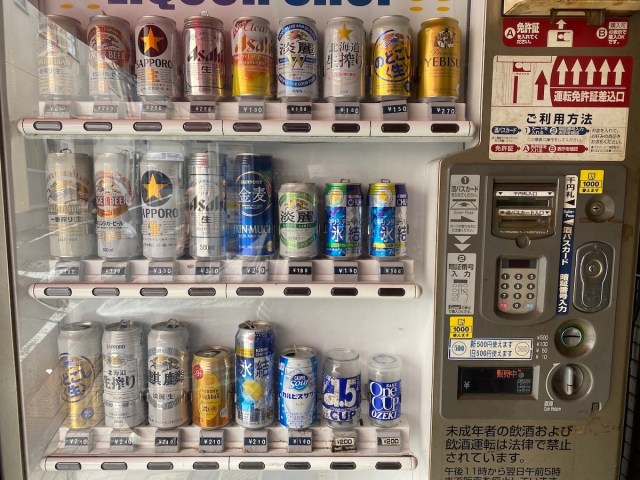
Remnants of a bygone era reveal the quirks of a previous payment system.
Japan is well-known for having vending machines on practically every other corner, providing people with a range of hot and cold beverages to choose from at any time of the day or night.
For those wanting an alcoholic form of refreshment, there are vending machines that provide that too, and while they’re not as ubiquitous as their non-alcoholic counterparts, they’re often found outside small liquor stores, standing as a testament to time with an old, weatherworn look.
What these ageing machines lack in modern looks they make up for in nostalgia, warming the hearts of people like our Japanese language reporter Takashi Harada, who’s always had a fondness for them. However, Takashi’s interest in these machines extends beyond their worn appearance because he’s always been keen to solve one of the mysteries connected to them.
You see, when you look closely at one of these machines, you’ll find there are three ways to operate it. You can either put your driver’s license into the slot marked in red near the top of the machine to verify your age, and then insert coins or cash into the slots marked out in blue, or you could use something called a “Sake Pass Card”.
▼ The slot for the “Sake-Pass” (sake is used as a blanket term for all types of alcoholic beverages in Japan) is written in Japanese and English on the machine.
Takashi recently came across one of these machines outside a small liquor store, and when he saw it had a slot for the sake pass card, he wanted to talk to the owner about it. Unfortunately, it was a public holiday so the store was closed, and after going home to search the Internet for more information about the card, he found that very little was known or written about it.
What he was able to gather from his research was that the card could be used by people who didn’t own a driver’s license as a way to verify their age. Once it was inserted into the machine, the user would have to enter their personal identification number on the keypad before being able to select and pay for their purchase.
These days, it’s common for people to use a similar style of I.D. card called “Taspo” (once known as “Tobacco Card”) to buy cigarettes at vending machines in Japan, but Takashi had never met anyone with a “Sake-Pass” before. The lack of information about them and the fact that a lot of people in Japan had never seen one had Takashi’s curiosity piqued; owning a Sake Pass became one of Takashi’s new life goals.
He returned to the store when they were open so he could speak with someone who worked there. As luck would have it, the woman he ended up speaking to had been working there for a considerably long time so she could give him — and us — a bit of an insight into the mysterious Sake Pass.
Let’s take a look at their discussion below.
Takashi: “Excuse me – I’d like a Sake Pass card, is it possible to get one?”
Store clerk: “Sorry, what’s that? What do you mean?”
Takashi: “It’s a card written on the alcohol vending machine; does it still exist?”
Store clerk: “Oh, that’s right. The card reader is broken and can’t be used. Right now, you can just use regular money to buy things at the machine.”
Takashi: “Oh, it’s that style” (At this point he laughed nervously, hoping she wouldn’t think he was weird for being so interested in the Sake Pass)
Store clerk: “Yes – that’s how it works.”
Takashi: “By the way, is it not possible to get a Sake Pass anymore?”
Store clerk: “We’ve never used one. I think they’ve disappeared; it’s a very old machine.”
Takashi: “Just to be specific, how many years ago was it installed?”
Store clerk: “Well, it was a long time ago, maybe 15 to 20 years ago.”
Takashi: “Oh I see – that’s quite a while ago! But at that time you could buy things from the machine with a Sake Pass, right?”
Store clerk: “Yes, however…“
Takashi: “However…?”
Takashi now gulped in anticipation, hoping she would drop some important insider information
Store clerk: “The slots for 1,000-yen (US$9.11) bills and the Sake Pass card are close to each other so there were quite a few people who put the card in the wrong slot by mistake. I remember that well.”
Takashi: “Did the machine take the card even if it was in the wrong slot?”
Store clerk: “That’s right. I had to call the maker each time and I couldn’t get it out; it was hard work.”
Takashi: “So such an era existed. Can this Sake Pass card be found all over the country?”
Store clerk: “As far as I know, they don’t exist anymore.”
Takashi: “While we’re on the topic, alcohol vending machines are also pretty rare. Are they becoming fewer nationwide?”
Store clerk: “There aren’t many of them around. The one we have is old so I wonder how much longer we can use it for. But we’ll use it for as long as we can.”
Takashi thanked the lady for sharing such useful information with him and helping to shed some light on the phantom Sake Pass. While he was happy he could learn a bit about the card, he can’t deny he felt a little down after coming to the realisation that he may never get his hands on one of these mysterious passes.
While he yearned for a time gone by when Sake Pass cards still existed, he decided to be grateful instead that these machines even exist today at all, complete with the now-defunct payment system attached. For now, though, the Sake Pass remains a phantom. If you own one, hopefully one day Takashi will be able to run into you…and solve the mystery of what they looked like once and for all!
Photos ©SoraNews24
● Want to hear about SoraNews24’s latest articles as soon as they’re published? Follow us on Facebook and Twitter!
[ Read in Japanese ]

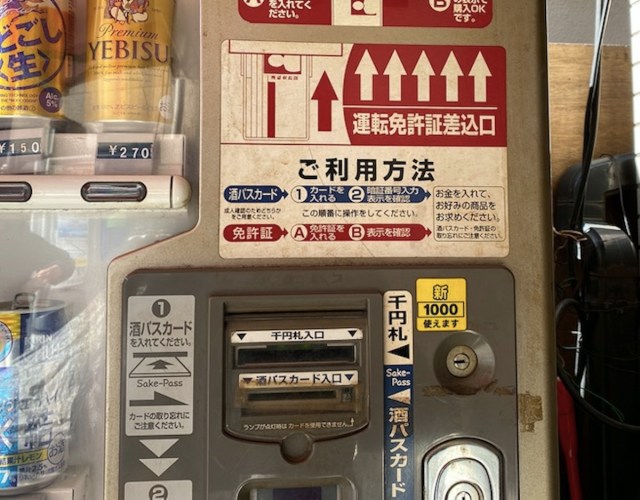
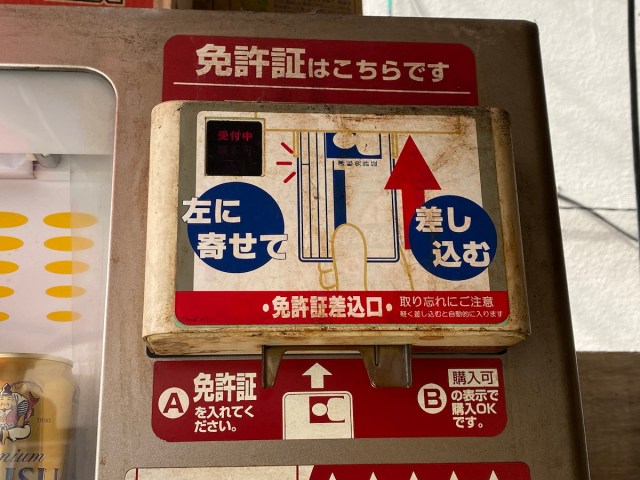
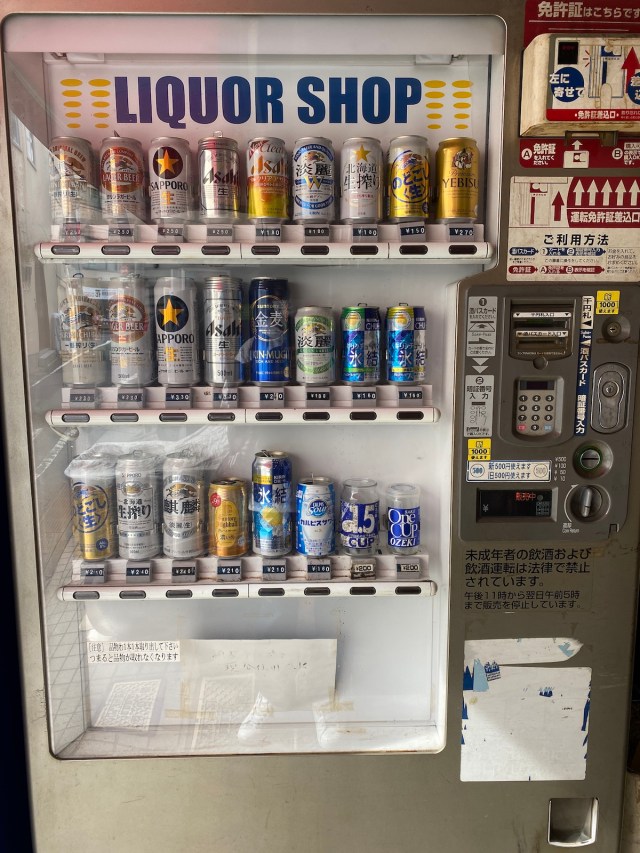
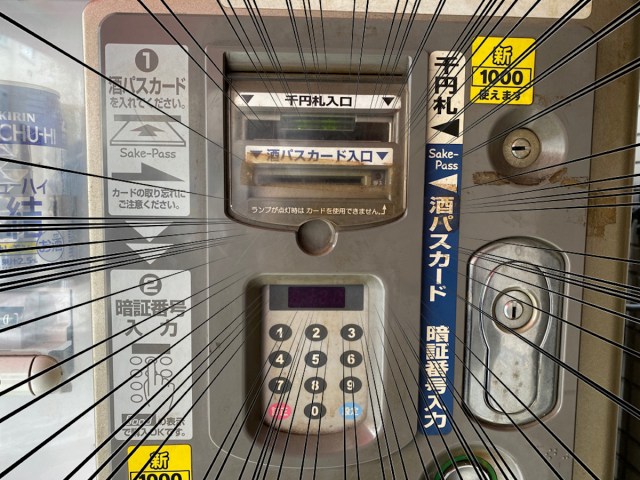
 It’s now legal to buy beer and cigarettes at self-checkout registers in Japan
It’s now legal to buy beer and cigarettes at self-checkout registers in Japan Nifty Japanese rice wine kit lets you brew your own tasty sake in the comfort of your own home
Nifty Japanese rice wine kit lets you brew your own tasty sake in the comfort of your own home Super-enthusiastic convenience store clerk fights the man, continues serving the people
Super-enthusiastic convenience store clerk fights the man, continues serving the people Many young Japanese people aren’t drinking sake these days
Many young Japanese people aren’t drinking sake these days Try-your-luck vending machine proves it doesn’t always pay to take a gamble
Try-your-luck vending machine proves it doesn’t always pay to take a gamble Foreigner’s request for help in Tokyo makes us sad for the state of society
Foreigner’s request for help in Tokyo makes us sad for the state of society Japanese city loses residents’ personal data, which was on paper being transported on a windy day
Japanese city loses residents’ personal data, which was on paper being transported on a windy day Seaside scenery, history, and so many desserts on Yokohama’s Akai Kutsu【Japan Loop Buses】
Seaside scenery, history, and so many desserts on Yokohama’s Akai Kutsu【Japan Loop Buses】 Should you add tartar sauce to Japanese curry rice? CoCo Ichi makes diners an unusual offer
Should you add tartar sauce to Japanese curry rice? CoCo Ichi makes diners an unusual offer Red light district sushi restaurant in Tokyo shows us just how wrong we were about it
Red light district sushi restaurant in Tokyo shows us just how wrong we were about it Akihabara pop-up shop sells goods made by Japanese prison inmates
Akihabara pop-up shop sells goods made by Japanese prison inmates Ghibli Park now selling “Grilled Frogs” from food cart in Valley of Witches
Ghibli Park now selling “Grilled Frogs” from food cart in Valley of Witches Princesses, fruits, and blacksmiths: Study reveals the 30 most unusual family names in Japan
Princesses, fruits, and blacksmiths: Study reveals the 30 most unusual family names in Japan Harajuku Station’s beautiful old wooden building is set to return, with a new complex around it
Harajuku Station’s beautiful old wooden building is set to return, with a new complex around it Japanese company starts project to restore Nakagin Capsules to capsule hotel
Japanese company starts project to restore Nakagin Capsules to capsule hotel McDonald’s new Happy Meals offer up cute and practical Sanrio lifestyle goods
McDonald’s new Happy Meals offer up cute and practical Sanrio lifestyle goods Japanese ramen restaurants under pressure from new yen banknotes
Japanese ramen restaurants under pressure from new yen banknotes French Fries Bread in Tokyo’s Shibuya becomes a hit on social media
French Fries Bread in Tokyo’s Shibuya becomes a hit on social media Studio Ghibli releases new action figures featuring Nausicaä of the Valley of the Wind characters
Studio Ghibli releases new action figures featuring Nausicaä of the Valley of the Wind characters New private rooms on Tokaido Shinkansen change the way we travel from Tokyo to Kyoto
New private rooms on Tokaido Shinkansen change the way we travel from Tokyo to Kyoto Tokyo Tsukiji fish market site to be redeveloped with 50,000-seat stadium, hotel, shopping center
Tokyo Tsukiji fish market site to be redeveloped with 50,000-seat stadium, hotel, shopping center All-you-can-drink Starbucks and amazing views part of Tokyo’s new 170 meter-high sky lounge
All-you-can-drink Starbucks and amazing views part of Tokyo’s new 170 meter-high sky lounge Beautiful Ghibli sealing wax kits let you create accessories and elegant letter decorations【Pics】
Beautiful Ghibli sealing wax kits let you create accessories and elegant letter decorations【Pics】 Studio Ghibli releases Kiki’s Delivery Service chocolate cake pouches in Japan
Studio Ghibli releases Kiki’s Delivery Service chocolate cake pouches in Japan New definition of “Japanese whiskey” goes into effect to prevent fakes from fooling overseas buyers
New definition of “Japanese whiskey” goes into effect to prevent fakes from fooling overseas buyers Our Japanese reporter visits Costco in the U.S., finds super American and very Japanese things
Our Japanese reporter visits Costco in the U.S., finds super American and very Japanese things Studio Ghibli unveils Mother’s Day gift set that captures the love in My Neighbour Totoro
Studio Ghibli unveils Mother’s Day gift set that captures the love in My Neighbour Totoro More foreign tourists than ever before in history visited Japan last month
More foreign tourists than ever before in history visited Japan last month New Pokémon cakes let you eat your way through Pikachu and all the Eevee evolutions
New Pokémon cakes let you eat your way through Pikachu and all the Eevee evolutions Sales of Japan’s most convenient train ticket/shopping payment cards suspended indefinitely
Sales of Japan’s most convenient train ticket/shopping payment cards suspended indefinitely Sold-out Studio Ghibli desktop humidifiers are back so Totoro can help you through the dry season
Sold-out Studio Ghibli desktop humidifiers are back so Totoro can help you through the dry season Japanese government to make first change to romanization spelling rules since the 1950s
Japanese government to make first change to romanization spelling rules since the 1950s Ghibli founders Toshio Suzuki and Hayao Miyazaki contribute to Japanese whisky Totoro label design
Ghibli founders Toshio Suzuki and Hayao Miyazaki contribute to Japanese whisky Totoro label design Doraemon found buried at sea as scene from 1993 anime becomes real life【Photos】
Doraemon found buried at sea as scene from 1993 anime becomes real life【Photos】 Tokyo’s most famous Starbucks is closed
Tokyo’s most famous Starbucks is closed One Piece characters’ nationalities revealed, but fans have mixed opinions
One Piece characters’ nationalities revealed, but fans have mixed opinions We asked a Uniqlo employee what four things we should buy and their suggestions didn’t disappoint
We asked a Uniqlo employee what four things we should buy and their suggestions didn’t disappoint This may look like an ordinary vending machine from afar, but it’s a different picture up close
This may look like an ordinary vending machine from afar, but it’s a different picture up close Japanese vending machine is the only one of its kind in Japan, dubbed the “phantom machine”
Japanese vending machine is the only one of its kind in Japan, dubbed the “phantom machine” Japan’s most mysterious vending machine sells fukubako, boxes filled with…something【Photos】
Japan’s most mysterious vending machine sells fukubako, boxes filled with…something【Photos】 We buy oysters from a Japanese vending machine
We buy oysters from a Japanese vending machine Why is it so hard to find hot sake in convenience stores in Japan?
Why is it so hard to find hot sake in convenience stores in Japan? Class up your campsite with these Japanese sake pouches designed for the outdoors
Class up your campsite with these Japanese sake pouches designed for the outdoors We tried Akihabara’s Star Kebab sushi roll and it changed our world
We tried Akihabara’s Star Kebab sushi roll and it changed our world Human hair from India helps make Japanese buses more efficient
Human hair from India helps make Japanese buses more efficient Some of Japan’s most iconic vending machines will soon be no more
Some of Japan’s most iconic vending machines will soon be no more Mask vending machines pop up at train stations around Taiwan to help commuters avoid fines
Mask vending machines pop up at train stations around Taiwan to help commuters avoid fines First-ever foot-operated vending machine appears in Japan during pandemic
First-ever foot-operated vending machine appears in Japan during pandemic Japanese vending machines will now let your buy things using your face
Japanese vending machines will now let your buy things using your face Otaku crime: Kyoto police arrest man for selling counterfeit ultra-rare Yu-Gi-Oh! card
Otaku crime: Kyoto police arrest man for selling counterfeit ultra-rare Yu-Gi-Oh! card We caved in to curiosity and bought a mystery box from a strange vending machine in Akihabara
We caved in to curiosity and bought a mystery box from a strange vending machine in Akihabara How much will three packs of Pokémon cards bought overseas fetch in Japan?
How much will three packs of Pokémon cards bought overseas fetch in Japan? Sake and Japanese convenience store ice cream go great together, but there’s an even better combo
Sake and Japanese convenience store ice cream go great together, but there’s an even better combo
Leave a Reply